The Games That Really Made The
Atari 2600 Great
In my last article, "The Games That Really
Ruined The Atari 2600", I focused on three primary game disasters that Atari
unleashed on the general public in the early 1980s that helped set the stage
for both the decline of Atari and the home game market implosion of 1984.
Although there were other companies that came on the scene to make matters
worse by peddling a ton of garbage games that would have a hard time being
sold even in bargain bins, Atari had set up players' expectations for great
things with Pac-Man, E.T., and the SwordQuest series
appearing on the 2600, only to dash their expectations against the rocks of
great disappointment with their poor delivery. Yet even among the dross
of games, 2600 owners found some real gems worth hanging onto that would make
today's gaming retrophiles bid on eBay auctions and try out game system
emulation on their computers to reclaim the joys of yesteryear's digital
entertainment. Though most of us would have our own individual lists of
games for the 2600 that we would consider great for our own reasons, this
article will focus mostly on the games that most people who owned that
system would consider great:
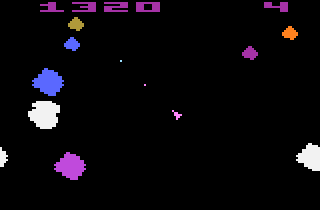 1. Asteroids, Missile Command,
and Space Invaders -- All three of these games were at the height of their
popularity in the arcades when Atari decided to make home versions of them for
the Atari 2600, and though they were scaled down adaptations that not only had
to deal with memory constraints, but also graphical and control limits in the
case of Asteroids and Missile Command -- the former using vector
graphics and a five-button control panel, the latter using a trackball
controller that Atari and some third-party companies would later produce --
what they lost was compensated greatly with the amount of game variations the
programmers packed in each title, adding variety to what would have been
otherwise somewhat inferior translations. These were definitely the
games that helped Atari sell 2600s in the late 1970s to early 1980s.
1. Asteroids, Missile Command,
and Space Invaders -- All three of these games were at the height of their
popularity in the arcades when Atari decided to make home versions of them for
the Atari 2600, and though they were scaled down adaptations that not only had
to deal with memory constraints, but also graphical and control limits in the
case of Asteroids and Missile Command -- the former using vector
graphics and a five-button control panel, the latter using a trackball
controller that Atari and some third-party companies would later produce --
what they lost was compensated greatly with the amount of game variations the
programmers packed in each title, adding variety to what would have been
otherwise somewhat inferior translations. These were definitely the
games that helped Atari sell 2600s in the late 1970s to early 1980s.
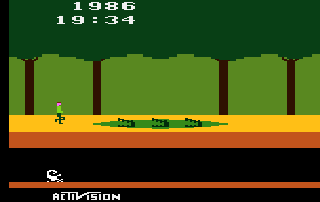 2. Activision games -- Atari's loss
of programmers who were seeking recognition for their work was certainly gain
for Atari 2600 owners when the same programmers formed Activision in 1980,
producing games outside of Atari's control with significantly better graphics
and more interesting gameplay. They helped bolster the system's anemic
sports games lineup with Boxing, Fishing Derby, Skiing, Ice Hockey,
Tennis, and just in time for the 1984 Summer Olympics, Decathlon.
As for arcade/action game titles, Activision has a few dozen titles with
varying themes and gameplay concepts that provided something for everyone.
Space gamers were treated to Laser Blast, Star Master,
Megamania, and Beamrider. Race-car players got Dragster,
Grand Prix, and Enduro. Adventure game fans took hold of
Pitfall, Pitfall II: The Lost Caverns, and H.E.R.O.
There was even a game that simulated operating a space shuttle even within the
limited capabilities of the Atari 2600. Programmers like David Crane,
Steve Cartwright, and Carol Shaw became prominent figures and even offered
advice to gamers for playing their games right in the instruction sheets
themselves. Of course, the "Activision magic" would last until the
mid-1980s, when Activision would go from developing original games to
translating arcade games for the Atari 2600 such as Kung-Fu Master,
Double Dragon, Commando, and Rampage, with varying degrees
of success. Activision also later picked up the rights to re-release
2600 games designed by Imagic, another third-party company formed by
programmers who previously worked for Atari, who designed some real winners
like Demon Attack and Atlantis.
2. Activision games -- Atari's loss
of programmers who were seeking recognition for their work was certainly gain
for Atari 2600 owners when the same programmers formed Activision in 1980,
producing games outside of Atari's control with significantly better graphics
and more interesting gameplay. They helped bolster the system's anemic
sports games lineup with Boxing, Fishing Derby, Skiing, Ice Hockey,
Tennis, and just in time for the 1984 Summer Olympics, Decathlon.
As for arcade/action game titles, Activision has a few dozen titles with
varying themes and gameplay concepts that provided something for everyone.
Space gamers were treated to Laser Blast, Star Master,
Megamania, and Beamrider. Race-car players got Dragster,
Grand Prix, and Enduro. Adventure game fans took hold of
Pitfall, Pitfall II: The Lost Caverns, and H.E.R.O.
There was even a game that simulated operating a space shuttle even within the
limited capabilities of the Atari 2600. Programmers like David Crane,
Steve Cartwright, and Carol Shaw became prominent figures and even offered
advice to gamers for playing their games right in the instruction sheets
themselves. Of course, the "Activision magic" would last until the
mid-1980s, when Activision would go from developing original games to
translating arcade games for the Atari 2600 such as Kung-Fu Master,
Double Dragon, Commando, and Rampage, with varying degrees
of success. Activision also later picked up the rights to re-release
2600 games designed by Imagic, another third-party company formed by
programmers who previously worked for Atari, who designed some real winners
like Demon Attack and Atlantis.
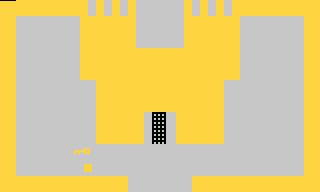 3. Adventure -- Atari's first
attempt at doing an adventure game based loosely on the popular TSR Games'
Dungeons & Dragons role-playing game wasn't much in the way of graphics,
sound, or even gameplay -- it had a very simplistic quest goal that could be
accomplished within a few hours of play, even less if you're playing Game 1.
However, what made this game popular was that its programmer, Warren Robinett,
hid his name within a special room in the game that the player had to find a
special object in order to enter into. Eventually, players found it and
the secret spread to where a whole community of gamers knew about this "secret
room" trick. Atari, when they ended up finding out about it, ended up
allowing programmers to put little tricks in the games they programmed to
reveal hidden initials to those lucky enough to find them. Aside from
this, Adventure also spawned other games that took its original
inspiration even further, resulting in games like Magnavox's Quest For The
Rings for the Odyssey 2, Mattel's Advanced Dungeons & Dragons game
series for the Intellivision, and even Atari's failed follow-up, the
Swordquest series for the 2600.
3. Adventure -- Atari's first
attempt at doing an adventure game based loosely on the popular TSR Games'
Dungeons & Dragons role-playing game wasn't much in the way of graphics,
sound, or even gameplay -- it had a very simplistic quest goal that could be
accomplished within a few hours of play, even less if you're playing Game 1.
However, what made this game popular was that its programmer, Warren Robinett,
hid his name within a special room in the game that the player had to find a
special object in order to enter into. Eventually, players found it and
the secret spread to where a whole community of gamers knew about this "secret
room" trick. Atari, when they ended up finding out about it, ended up
allowing programmers to put little tricks in the games they programmed to
reveal hidden initials to those lucky enough to find them. Aside from
this, Adventure also spawned other games that took its original
inspiration even further, resulting in games like Magnavox's Quest For The
Rings for the Odyssey 2, Mattel's Advanced Dungeons & Dragons game
series for the Intellivision, and even Atari's failed follow-up, the
Swordquest series for the 2600.
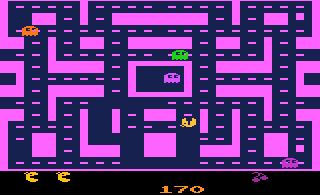 4. Ms. Pac-Man -- A year after
Atari's botched-up Pac-Man port for the 2600, the company gave us the
home version of its arcade sequel, Ms. Pac-Man, which was designed not
by Namco, but by a company of game programmers who worked for Midway at the
time. The yellow femme fatale's game was such an excellent game because
it improved on what made Pac-Man so great and added some new touches
like fruit prizes that moved around the maze, tempting the lady gobbler to
grab it before it disappears even in the midst of pursuing ghosts.
Although the 2600 version of that game was released with very little fanfare
compared to its predecessor, save for a television commercial that featured an
animated Ms. Pac-Man doing a Liza Minnelli-ish "I'm more than just Pac-Man
with a bow," it was a major improvement over the same system's Pac-Man
in that it kept just about everything in the arcade original intact, with only
minor adjustments made to the four screens that she and her ghost buddies
roamed around in in order to fit onto the TV screen and the amount of memory
the 2600 could read. Even more interesting was that 2600 Ms. Pac-Man
included four different skill levels that allowed players to choose how many
ghosts they want to contend with in the game.
4. Ms. Pac-Man -- A year after
Atari's botched-up Pac-Man port for the 2600, the company gave us the
home version of its arcade sequel, Ms. Pac-Man, which was designed not
by Namco, but by a company of game programmers who worked for Midway at the
time. The yellow femme fatale's game was such an excellent game because
it improved on what made Pac-Man so great and added some new touches
like fruit prizes that moved around the maze, tempting the lady gobbler to
grab it before it disappears even in the midst of pursuing ghosts.
Although the 2600 version of that game was released with very little fanfare
compared to its predecessor, save for a television commercial that featured an
animated Ms. Pac-Man doing a Liza Minnelli-ish "I'm more than just Pac-Man
with a bow," it was a major improvement over the same system's Pac-Man
in that it kept just about everything in the arcade original intact, with only
minor adjustments made to the four screens that she and her ghost buddies
roamed around in in order to fit onto the TV screen and the amount of memory
the 2600 could read. Even more interesting was that 2600 Ms. Pac-Man
included four different skill levels that allowed players to choose how many
ghosts they want to contend with in the game.
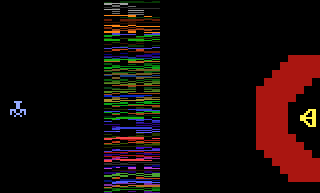 5. Yars' Revenge -- At the same
time Atari's 2600 versions of Pac-Man and Defender were being
sold in stores and played by gamers, this game came out in the middle of 1982.
What made Yars' Revenge so interesting was that Atari had originally
intended for this game to be the home version of CinemaTronics' Star Castle
arcade game, but apparently the limitations of the 2600 had forced programmers
to come up with something remarkably similar to its inspiration and yet
different at the same time. The object of the game was to guide the Yar
fly-warrior (Yars, according to the game's pack-in comic book, were humanoid
houseflies that colonized an entire solar system due to their ability to
journey through space without need for spacesuits) toward the goal of
destroying the Qotile home base (the Qotiles were responsible for destroying
one of the Yars' colonized planets, hence the game's title) by first chipping
away at their energy shield and then using the powerful Zorlon Cannon to
destroy the base behind the shield. What the player must watch out for
is the heat-seeking Destroyer Missile that could destroy the player's Yar on
contact (unless he hides himself within a rainbow-colored zone in the middle
of the screen), the Swirls that the Qotile base launches periodically toward
the Yar no matter where he is, and, for an added twist, the Zorlon Cannon's energy blast when the
player activates a shot from it. This game has re-appeared on both the Gameboy Color system and on Jakks Pacific's Atari TV games unit.
5. Yars' Revenge -- At the same
time Atari's 2600 versions of Pac-Man and Defender were being
sold in stores and played by gamers, this game came out in the middle of 1982.
What made Yars' Revenge so interesting was that Atari had originally
intended for this game to be the home version of CinemaTronics' Star Castle
arcade game, but apparently the limitations of the 2600 had forced programmers
to come up with something remarkably similar to its inspiration and yet
different at the same time. The object of the game was to guide the Yar
fly-warrior (Yars, according to the game's pack-in comic book, were humanoid
houseflies that colonized an entire solar system due to their ability to
journey through space without need for spacesuits) toward the goal of
destroying the Qotile home base (the Qotiles were responsible for destroying
one of the Yars' colonized planets, hence the game's title) by first chipping
away at their energy shield and then using the powerful Zorlon Cannon to
destroy the base behind the shield. What the player must watch out for
is the heat-seeking Destroyer Missile that could destroy the player's Yar on
contact (unless he hides himself within a rainbow-colored zone in the middle
of the screen), the Swirls that the Qotile base launches periodically toward
the Yar no matter where he is, and, for an added twist, the Zorlon Cannon's energy blast when the
player activates a shot from it. This game has re-appeared on both the Gameboy Color system and on Jakks Pacific's Atari TV games unit.
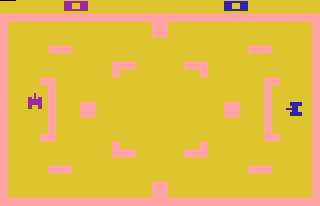 6. Combat -- The pack-in game that
originally came with every Atari 2600, Combat was the home version of
Atari's own arcade game Tank, manufactured by its Kee Games division.
Though rather primitive to later games that both followed it and also copied
its basic concept (like Mattel's Armor Battle for the Intellivision)
and also needing a second player in order to enjoy it, Combat featured
27 different game variations which also included aerial combat games
Biplane and Jet Fighter and some wild alterations to Tank
such as having ricocheting shots and invisible tanks.
6. Combat -- The pack-in game that
originally came with every Atari 2600, Combat was the home version of
Atari's own arcade game Tank, manufactured by its Kee Games division.
Though rather primitive to later games that both followed it and also copied
its basic concept (like Mattel's Armor Battle for the Intellivision)
and also needing a second player in order to enjoy it, Combat featured
27 different game variations which also included aerial combat games
Biplane and Jet Fighter and some wild alterations to Tank
such as having ricocheting shots and invisible tanks.
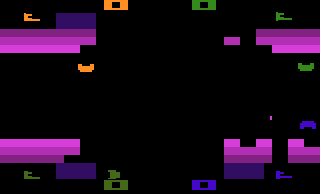 7. Warlords -- Among the games
Atari designed for the 2600 that used its paddle controllers such as
Breakout, Circus Atari, Night Driver, and Video Olympics
was this game based on a little-known Atari arcade game from the late 1970s.
Something like a very competitive version of Breakout, where players
controlled shields that protected walls surrounding their warlord characters
from a bouncing fireball that would chip away at the blocks comprising the
walls, Warlords would become a great party game for multiple players. Right now,
this game lives on in the form of Castle Crisis for the Atari 5200 and 8-bit
personal computers.
7. Warlords -- Among the games
Atari designed for the 2600 that used its paddle controllers such as
Breakout, Circus Atari, Night Driver, and Video Olympics
was this game based on a little-known Atari arcade game from the late 1970s.
Something like a very competitive version of Breakout, where players
controlled shields that protected walls surrounding their warlord characters
from a bouncing fireball that would chip away at the blocks comprising the
walls, Warlords would become a great party game for multiple players. Right now,
this game lives on in the form of Castle Crisis for the Atari 5200 and 8-bit
personal computers.
 1. Asteroids, Missile Command,
and Space Invaders -- All three of these games were at the height of their
popularity in the arcades when Atari decided to make home versions of them for
the Atari 2600, and though they were scaled down adaptations that not only had
to deal with memory constraints, but also graphical and control limits in the
case of Asteroids and Missile Command -- the former using vector
graphics and a five-button control panel, the latter using a trackball
controller that Atari and some third-party companies would later produce --
what they lost was compensated greatly with the amount of game variations the
programmers packed in each title, adding variety to what would have been
otherwise somewhat inferior translations. These were definitely the
games that helped Atari sell 2600s in the late 1970s to early 1980s.
1. Asteroids, Missile Command,
and Space Invaders -- All three of these games were at the height of their
popularity in the arcades when Atari decided to make home versions of them for
the Atari 2600, and though they were scaled down adaptations that not only had
to deal with memory constraints, but also graphical and control limits in the
case of Asteroids and Missile Command -- the former using vector
graphics and a five-button control panel, the latter using a trackball
controller that Atari and some third-party companies would later produce --
what they lost was compensated greatly with the amount of game variations the
programmers packed in each title, adding variety to what would have been
otherwise somewhat inferior translations. These were definitely the
games that helped Atari sell 2600s in the late 1970s to early 1980s. 2. Activision games -- Atari's loss
of programmers who were seeking recognition for their work was certainly gain
for Atari 2600 owners when the same programmers formed Activision in 1980,
producing games outside of Atari's control with significantly better graphics
and more interesting gameplay. They helped bolster the system's anemic
sports games lineup with Boxing, Fishing Derby, Skiing, Ice Hockey,
Tennis, and just in time for the 1984 Summer Olympics, Decathlon.
As for arcade/action game titles, Activision has a few dozen titles with
varying themes and gameplay concepts that provided something for everyone.
Space gamers were treated to Laser Blast, Star Master,
Megamania, and Beamrider. Race-car players got Dragster,
Grand Prix, and Enduro. Adventure game fans took hold of
Pitfall, Pitfall II: The Lost Caverns, and H.E.R.O.
There was even a game that simulated operating a space shuttle even within the
limited capabilities of the Atari 2600. Programmers like David Crane,
Steve Cartwright, and Carol Shaw became prominent figures and even offered
advice to gamers for playing their games right in the instruction sheets
themselves. Of course, the "Activision magic" would last until the
mid-1980s, when Activision would go from developing original games to
translating arcade games for the Atari 2600 such as Kung-Fu Master,
Double Dragon, Commando, and Rampage, with varying degrees
of success. Activision also later picked up the rights to re-release
2600 games designed by Imagic, another third-party company formed by
programmers who previously worked for Atari, who designed some real winners
like Demon Attack and Atlantis.
2. Activision games -- Atari's loss
of programmers who were seeking recognition for their work was certainly gain
for Atari 2600 owners when the same programmers formed Activision in 1980,
producing games outside of Atari's control with significantly better graphics
and more interesting gameplay. They helped bolster the system's anemic
sports games lineup with Boxing, Fishing Derby, Skiing, Ice Hockey,
Tennis, and just in time for the 1984 Summer Olympics, Decathlon.
As for arcade/action game titles, Activision has a few dozen titles with
varying themes and gameplay concepts that provided something for everyone.
Space gamers were treated to Laser Blast, Star Master,
Megamania, and Beamrider. Race-car players got Dragster,
Grand Prix, and Enduro. Adventure game fans took hold of
Pitfall, Pitfall II: The Lost Caverns, and H.E.R.O.
There was even a game that simulated operating a space shuttle even within the
limited capabilities of the Atari 2600. Programmers like David Crane,
Steve Cartwright, and Carol Shaw became prominent figures and even offered
advice to gamers for playing their games right in the instruction sheets
themselves. Of course, the "Activision magic" would last until the
mid-1980s, when Activision would go from developing original games to
translating arcade games for the Atari 2600 such as Kung-Fu Master,
Double Dragon, Commando, and Rampage, with varying degrees
of success. Activision also later picked up the rights to re-release
2600 games designed by Imagic, another third-party company formed by
programmers who previously worked for Atari, who designed some real winners
like Demon Attack and Atlantis. 3. Adventure -- Atari's first
attempt at doing an adventure game based loosely on the popular TSR Games'
Dungeons & Dragons role-playing game wasn't much in the way of graphics,
sound, or even gameplay -- it had a very simplistic quest goal that could be
accomplished within a few hours of play, even less if you're playing Game 1.
However, what made this game popular was that its programmer, Warren Robinett,
hid his name within a special room in the game that the player had to find a
special object in order to enter into. Eventually, players found it and
the secret spread to where a whole community of gamers knew about this "secret
room" trick. Atari, when they ended up finding out about it, ended up
allowing programmers to put little tricks in the games they programmed to
reveal hidden initials to those lucky enough to find them. Aside from
this, Adventure also spawned other games that took its original
inspiration even further, resulting in games like Magnavox's Quest For The
Rings for the Odyssey 2, Mattel's Advanced Dungeons & Dragons game
series for the Intellivision, and even Atari's failed follow-up, the
Swordquest series for the 2600.
3. Adventure -- Atari's first
attempt at doing an adventure game based loosely on the popular TSR Games'
Dungeons & Dragons role-playing game wasn't much in the way of graphics,
sound, or even gameplay -- it had a very simplistic quest goal that could be
accomplished within a few hours of play, even less if you're playing Game 1.
However, what made this game popular was that its programmer, Warren Robinett,
hid his name within a special room in the game that the player had to find a
special object in order to enter into. Eventually, players found it and
the secret spread to where a whole community of gamers knew about this "secret
room" trick. Atari, when they ended up finding out about it, ended up
allowing programmers to put little tricks in the games they programmed to
reveal hidden initials to those lucky enough to find them. Aside from
this, Adventure also spawned other games that took its original
inspiration even further, resulting in games like Magnavox's Quest For The
Rings for the Odyssey 2, Mattel's Advanced Dungeons & Dragons game
series for the Intellivision, and even Atari's failed follow-up, the
Swordquest series for the 2600. 4. Ms. Pac-Man -- A year after
Atari's botched-up Pac-Man port for the 2600, the company gave us the
home version of its arcade sequel, Ms. Pac-Man, which was designed not
by Namco, but by a company of game programmers who worked for Midway at the
time. The yellow femme fatale's game was such an excellent game because
it improved on what made Pac-Man so great and added some new touches
like fruit prizes that moved around the maze, tempting the lady gobbler to
grab it before it disappears even in the midst of pursuing ghosts.
Although the 2600 version of that game was released with very little fanfare
compared to its predecessor, save for a television commercial that featured an
animated Ms. Pac-Man doing a Liza Minnelli-ish "I'm more than just Pac-Man
with a bow," it was a major improvement over the same system's Pac-Man
in that it kept just about everything in the arcade original intact, with only
minor adjustments made to the four screens that she and her ghost buddies
roamed around in in order to fit onto the TV screen and the amount of memory
the 2600 could read. Even more interesting was that 2600 Ms. Pac-Man
included four different skill levels that allowed players to choose how many
ghosts they want to contend with in the game.
4. Ms. Pac-Man -- A year after
Atari's botched-up Pac-Man port for the 2600, the company gave us the
home version of its arcade sequel, Ms. Pac-Man, which was designed not
by Namco, but by a company of game programmers who worked for Midway at the
time. The yellow femme fatale's game was such an excellent game because
it improved on what made Pac-Man so great and added some new touches
like fruit prizes that moved around the maze, tempting the lady gobbler to
grab it before it disappears even in the midst of pursuing ghosts.
Although the 2600 version of that game was released with very little fanfare
compared to its predecessor, save for a television commercial that featured an
animated Ms. Pac-Man doing a Liza Minnelli-ish "I'm more than just Pac-Man
with a bow," it was a major improvement over the same system's Pac-Man
in that it kept just about everything in the arcade original intact, with only
minor adjustments made to the four screens that she and her ghost buddies
roamed around in in order to fit onto the TV screen and the amount of memory
the 2600 could read. Even more interesting was that 2600 Ms. Pac-Man
included four different skill levels that allowed players to choose how many
ghosts they want to contend with in the game. 5. Yars' Revenge -- At the same
time Atari's 2600 versions of Pac-Man and Defender were being
sold in stores and played by gamers, this game came out in the middle of 1982.
What made Yars' Revenge so interesting was that Atari had originally
intended for this game to be the home version of CinemaTronics' Star Castle
arcade game, but apparently the limitations of the 2600 had forced programmers
to come up with something remarkably similar to its inspiration and yet
different at the same time. The object of the game was to guide the Yar
fly-warrior (Yars, according to the game's pack-in comic book, were humanoid
houseflies that colonized an entire solar system due to their ability to
journey through space without need for spacesuits) toward the goal of
destroying the Qotile home base (the Qotiles were responsible for destroying
one of the Yars' colonized planets, hence the game's title) by first chipping
away at their energy shield and then using the powerful Zorlon Cannon to
destroy the base behind the shield. What the player must watch out for
is the heat-seeking Destroyer Missile that could destroy the player's Yar on
contact (unless he hides himself within a rainbow-colored zone in the middle
of the screen), the Swirls that the Qotile base launches periodically toward
the Yar no matter where he is, and, for an added twist, the Zorlon Cannon's energy blast when the
player activates a shot from it. This game has re-appeared on both the Gameboy Color system and on Jakks Pacific's Atari TV games unit.
5. Yars' Revenge -- At the same
time Atari's 2600 versions of Pac-Man and Defender were being
sold in stores and played by gamers, this game came out in the middle of 1982.
What made Yars' Revenge so interesting was that Atari had originally
intended for this game to be the home version of CinemaTronics' Star Castle
arcade game, but apparently the limitations of the 2600 had forced programmers
to come up with something remarkably similar to its inspiration and yet
different at the same time. The object of the game was to guide the Yar
fly-warrior (Yars, according to the game's pack-in comic book, were humanoid
houseflies that colonized an entire solar system due to their ability to
journey through space without need for spacesuits) toward the goal of
destroying the Qotile home base (the Qotiles were responsible for destroying
one of the Yars' colonized planets, hence the game's title) by first chipping
away at their energy shield and then using the powerful Zorlon Cannon to
destroy the base behind the shield. What the player must watch out for
is the heat-seeking Destroyer Missile that could destroy the player's Yar on
contact (unless he hides himself within a rainbow-colored zone in the middle
of the screen), the Swirls that the Qotile base launches periodically toward
the Yar no matter where he is, and, for an added twist, the Zorlon Cannon's energy blast when the
player activates a shot from it. This game has re-appeared on both the Gameboy Color system and on Jakks Pacific's Atari TV games unit. 6. Combat -- The pack-in game that
originally came with every Atari 2600, Combat was the home version of
Atari's own arcade game Tank, manufactured by its Kee Games division.
Though rather primitive to later games that both followed it and also copied
its basic concept (like Mattel's Armor Battle for the Intellivision)
and also needing a second player in order to enjoy it, Combat featured
27 different game variations which also included aerial combat games
Biplane and Jet Fighter and some wild alterations to Tank
such as having ricocheting shots and invisible tanks.
6. Combat -- The pack-in game that
originally came with every Atari 2600, Combat was the home version of
Atari's own arcade game Tank, manufactured by its Kee Games division.
Though rather primitive to later games that both followed it and also copied
its basic concept (like Mattel's Armor Battle for the Intellivision)
and also needing a second player in order to enjoy it, Combat featured
27 different game variations which also included aerial combat games
Biplane and Jet Fighter and some wild alterations to Tank
such as having ricocheting shots and invisible tanks. 7. Warlords -- Among the games
Atari designed for the 2600 that used its paddle controllers such as
Breakout, Circus Atari, Night Driver, and Video Olympics
was this game based on a little-known Atari arcade game from the late 1970s.
Something like a very competitive version of Breakout, where players
controlled shields that protected walls surrounding their warlord characters
from a bouncing fireball that would chip away at the blocks comprising the
walls, Warlords would become a great party game for multiple players. Right now,
this game lives on in the form of Castle Crisis for the Atari 5200 and 8-bit
personal computers.
7. Warlords -- Among the games
Atari designed for the 2600 that used its paddle controllers such as
Breakout, Circus Atari, Night Driver, and Video Olympics
was this game based on a little-known Atari arcade game from the late 1970s.
Something like a very competitive version of Breakout, where players
controlled shields that protected walls surrounding their warlord characters
from a bouncing fireball that would chip away at the blocks comprising the
walls, Warlords would become a great party game for multiple players. Right now,
this game lives on in the form of Castle Crisis for the Atari 5200 and 8-bit
personal computers.